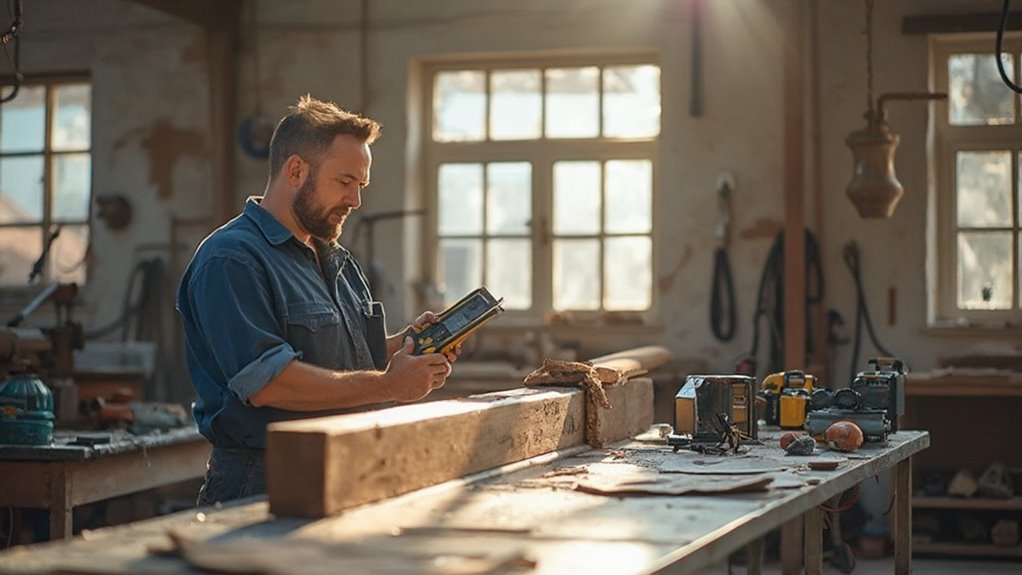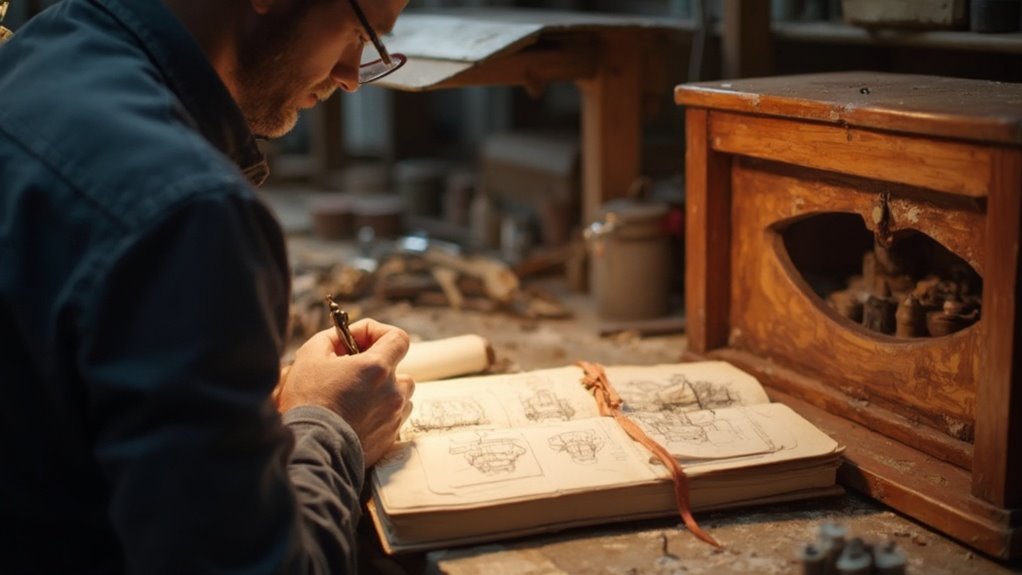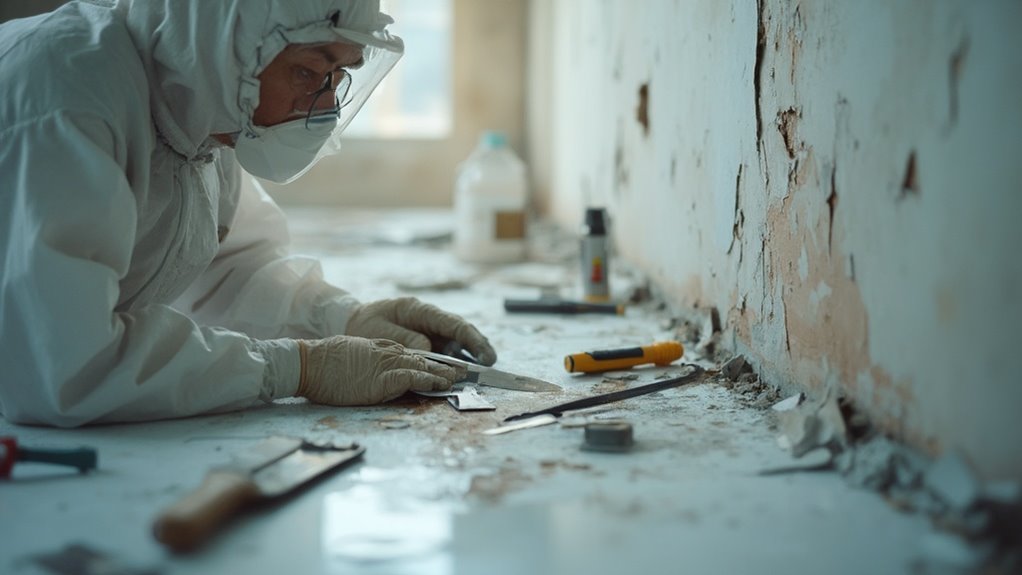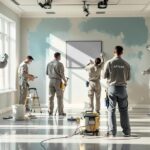Understanding the restoration process is crucial for you to manage recovery effectively. Start with a thorough assessment to identify visible and hidden damage, utilizing advanced inspection tools like moisture meters. Quick emergency mitigation can greatly lower costs, so make sure you take immediate action, like securing the property and removing water. The cleanup involves debris removal and sanitization to prevent mold. Meticulous reconstruction guarantees safety and aesthetics in your space. Documentation throughout this process acts as your roadmap. By focusing on clear communication and emotional support, you can streamline efforts and improve resilience. There's much more to investigate about each step.
Key Takeaways
- A detailed damage assessment uses advanced inspection techniques to identify visible and hidden issues critical for effective restoration.
- Rapid response strategies minimize damage, with professional teams mobilizing quickly to secure properties and stabilize structures.
- The cleanup process begins with debris removal, followed by deep cleaning to ensure safety and prevent mold growth.
- Thorough documentation throughout the restoration process provides a clear roadmap and aids in verifying progress and safety compliance.
- Effective communication and emotional support foster resilience, helping stakeholders navigate challenges during the restoration journey.
Assessment and Inspection

During the initial stages of the restoration process, a thorough assessment and inspection are crucial for understanding the full extent of the damage. You'll want to begin with a detailed damage assessment, examining affected areas for both visible and hidden issues. Employing advanced inspection techniques like moisture meters and thermal imaging cameras can reveal problems that aren't immediately apparent, such as hidden moisture levels in walls, floors, and ceilings, which can lead to mold growth. Additionally, understanding the type of water damage is vital for determining the appropriate restoration process.
As you conduct your visual inspection, look for signs like stains, discoloration, and structural irregularities. Identifying the source of water intrusion is vital, as it helps you address the root cause of the damage. Be vigilant for indicators of mold, as this is a common aftermath of water damage that can pose health risks. Accurate assessments ensure that you do not overlook any critical issues that could affect the restoration process.
Comprehensive documentation of your findings will guide your subsequent restoration efforts. Develop a detailed restoration plan based on your assessment, prioritizing tasks according to the urgency and severity of the damage. This roadmap will guarantee that you restore the property effectively, returning it to its pre-damage condition.
Emergency Mitigation Strategies
When emergencies strike, implementing rapid response techniques is essential to minimize damage. You'll want to secure your property effectively by using methods like boarding windows and reinforcing doors. These actions can greatly improve your safety and protect your assets during a crisis. Additionally, engaging with professional services ensures expertise in handling water damage situations, which is critical for effective emergency mitigation.
Rapid Response Techniques
Effective rapid response techniques are fundamental in mitigating damage during emergencies, guaranteeing that you can act swiftly and decisively when disaster strikes. Emergency preparedness is your first line of defense, and having a solid response plan can make all the difference. When a crisis occurs, teams are available around the clock, mobilizing within four hours in licensed areas to minimize damage.
Upon arrival, evaluating the extent of damage from fires or water is imperative. You'll want to verify that debris is removed and compromised structures are stabilized to prevent further harm. Utilizing advanced techniques, such as dehumidification, can considerably mitigate water damage. Immediate actions like implementing temporary flood defenses are critical.
Preserving valuable assets is likewise a priority. By quickly restoring and cleaning cherished belongings, you'll reduce emotional impact while enhancing safety for all involved. Early intervention is key; it helps you lower restoration costs and accelerates recovery, allowing individuals and businesses to resume their routines promptly. Ultimately, effective rapid response techniques not only protect your property but also preserve financial stability, making them indispensable in any emergency response planning strategy.
Property Securing Methods
In the aftermath of an emergency, safeguarding your property is vital to prevent further damage and guarantee safety. Implementing effective property securing methods is your first line of defense. Start by evaluating structural integrity to identify weak spots. Inspect walls, floors, and ceilings for signs of damage. If necessary, initiate water removal to prevent additional structural harm.
Next, take immediate action to secure the property. Board up windows and doors, tarp roofs, and install temporary fencing or barriers to restrict unauthorized access. Here's a breakdown of key strategies:
| Method | Purpose | Materials Needed |
|---|---|---|
| Barrier Installation | Prevent unauthorized entry | Plywood, fencing |
| Water Removal | Mitigate flooding risk | Industrial pumps, vacuums |
| Roof Tarping | Protect from rain and debris | Heavy-duty tarps |
| Structural Reinforcement | Stabilize weakened structures | Industrial-strength supports |
Finally, always prioritize safety measures. Remove hazards, dehumidify affected areas, and maintain air quality. By following these steps, you not only protect your property but likewise lay the groundwork for effective restoration.
Importance of Documentation

Documentation plays a vital role in the restoration process, acting as both a roadmap and a record of progress. By adhering to established documentation standards, you guarantee a consistent approach across all projects. Developing a Standard Operating Procedure (SOP) guide can streamline your documentation steps, while a checklist keeps you on track, guaranteeing no important information is overlooked.
Utilizing visual techniques is fundamental for capturing damage accurately. Photos and videos should encompass wide shots and close-ups, organized by room for clarity. Documenting the source of loss from multiple angles, with careful lighting adjustments, improves the accuracy of your records. Consistency is key; employing standardized note templates allows team members to record vital information uniformly.
Leverage modern technology, like restoration software, to improve efficiency. Digital tools facilitate real-time documentation, making it easily accessible for the whole team. Regular audits of your documentation process will help identify inconsistencies, promoting ongoing improvement. By mentoring new employees with experienced team members, you instill a culture of thorough documentation, guaranteeing accuracy and completeness throughout the restoration process. Adopt these practices, and you'll boost your restoration efforts greatly.
The Cleanup Process
After thorough documentation of the damage, the cleanup process begins, laying the groundwork for a successful restoration. The first step involves debris removal. You'll identify and remove damaged building materials, furniture, and personal items that can't be restored. Clearing out debris is essential to guarantee a safe working environment. Separate salvageable items from those that must be discarded, utilizing specialized equipment for heavy or hazardous debris. Remember to document all removed items for insurance and restoration purposes.
Next, focus on smoke, soot, and water contaminant cleanup. Use deep cleaning techniques to remove smoke and soot particles from surfaces, employing industrial air scrubbers and fogging equipment to eliminate odors. Clean all restorable items and structures affected by the damage, utilizing specialized cleaning products and confirming thorough ventilation.
Finally, clean and sanitize all surfaces, including walls, ceilings, and floors, to remove contaminants and prevent mold growth. Dispose of any materials that can't be sanitized and conduct final checks to verify that all areas are clean. A thorough inspection will prepare the site for restoration, guaranteeing safety measures are in place before moving forward.
Repair and Reconstruction Steps

Once the cleanup is complete, the repair and reconstruction steps can begin, paving the way for restoring your property to its former condition. Start with a thorough assessment of the damage, utilizing specialized equipment like moisture meters and thermal imaging cameras to uncover hidden issues. This initial evaluation helps identify necessary repair techniques and hazardous materials that could pose health risks.
Securing the property is vital. Board up windows and tarp roofs to protect against external elements while stabilizing the structure. Once secured, focus on structural repairs. Address damaged walls, floors, and ceilings, ensuring all work meets safety and building code standards. Don't overlook electrical and plumbing issues; these are critical for functionality.
For reconstruction methods, replace any compromised sections with new framing and sheetrock, and repair custom wooden elements like cabinets. Finish the process by painting walls and ceilings, installing trim and molding, and laying new flooring. These final touches not only improve aesthetics but furthermore restore your property to its pre-damage condition. With meticulous attention to detail, you'll have your space safe and fully functional once again.
Final Inspection Procedures
Conducting a final inspection is crucial to guarantee that your restoration project meets all required standards and is safe for occupancy. This inspection not only confirms structural integrity but additionally verifies the functionality and safety of systems installed. Use a thorough final checklist to guide your inspection process.
Here's a helpful table to organize your inspection:
| Inspection Area | Key Focus Areas | Inspection Tools |
|---|---|---|
| Structural Integrity | Walls, ceilings, floors, foundations | Level, moisture meter |
| Systems and Safety | Electrical and plumbing functionality | Multimeter, pressure gauge |
| Cosmetic Verification | Finished surfaces and decorative elements | Visual inspection tools |
| Safety Hazards | Exposed wiring, drainage issues | Electrical tester, camera |
| Client Satisfaction | Overall appearance and completeness | Client feedback forms |
Communication With Property Owners

Effective communication with property owners is essential throughout the restoration process. Establishing clear roles and responsibilities is your first step in trust building. Designate a primary contact person who thoroughly understands the technical and emotional nuances of the project. This individual will serve as a significant link between the client and the restoration team, ensuring that everyone is aligned.
Setting clear expectations is also important. At the outset, provide clients with a preliminary timeline and outline potential challenges. Regularly discuss the project's goals and progress, keeping everyone informed to prevent misunderstandings.
To maintain effective client communication, establish a schedule for updates—daily, bi-weekly, or weekly. Share milestones achieved and any necessary adjustments to the project's scope or timeline. Transparency is key; offer detailed explanations for any changes to reassure property owners.
Finally, be prepared for difficult conversations. Approach unforeseen challenges with empathy and professionalism. Collaborate with the property owner to investigate alternative solutions when necessary. Open and honest communication will reduce concerns and promote a strong partnership throughout the restoration journey.
Emotional Support During Restoration
How can emotional support transform the restoration experience for clients? Emotional validation techniques play an important role in building trust and creating a safe environment. When you feel understood and accepted, it encourages open communication, allowing you to share your feelings and concerns without judgment. This nurturing atmosphere can greatly reduce feelings of isolation and fear, which often accompany trauma.
Supportive communication strategies, such as active listening and empathetic responses, help regulate your emotions during the restoration process. These approaches provide comfort and reassurance, allowing you to manage anxiety, anger, and sadness more effectively. A strong support network, including caregivers and friends, can be instrumental in preventing emotional setbacks like depression and anxiety.
Moreover, emotional support boosts resilience by motivating you to keep moving forward. It instills optimism and helps you regain a sense of purpose, vital for your recovery journey. Engaging in activities like journaling or talking with trusted individuals can promote emotional rehabilitation, maintaining stability through various therapeutic practices. Ultimately, emotional support improves your ability to focus on healing and achieving emotional clarity, making the restoration process more manageable and hopeful.
Conclusion
To summarize, maneuvering through the restoration process can feel like piecing together a jigsaw puzzle. Each step—assessment, cleanup, and reconstruction—requires careful attention and communication. By understanding these stages and the importance of documentation, you can guarantee a smoother experience. Remember, you're not alone; professionals are there to guide you through every challenge. With patience and support, your property can be restored to its former glory, helping you move forward with confidence and peace of mind.







